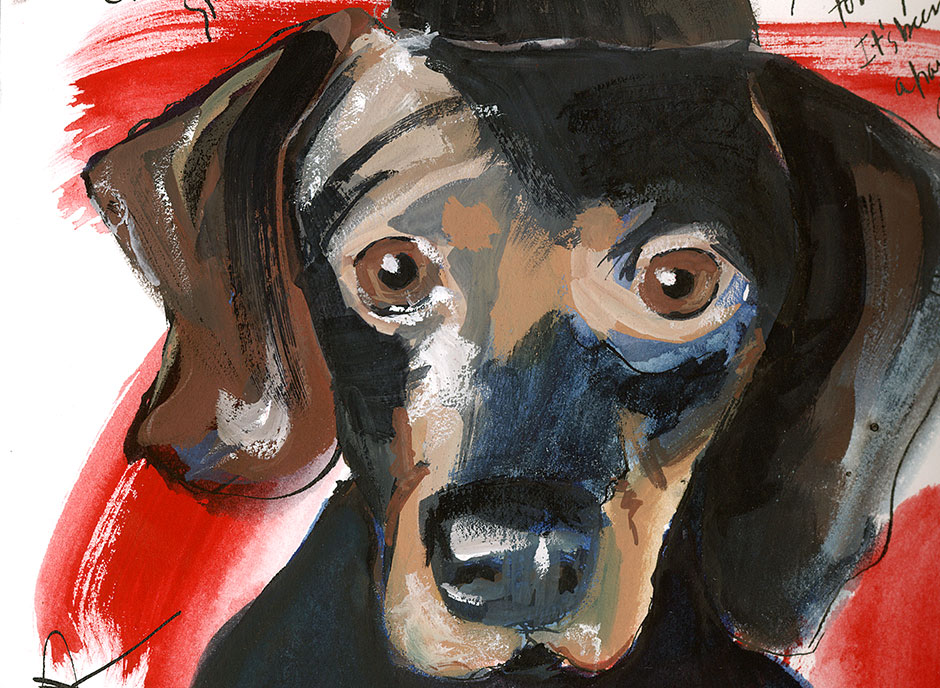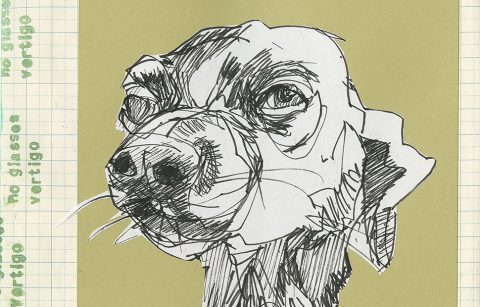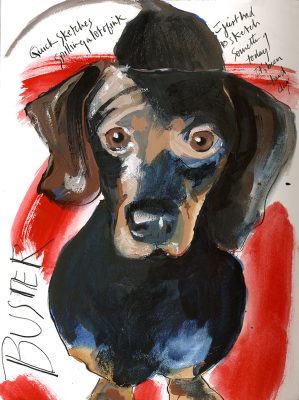
After Monday’s post on the Stoneground Gouache Pans I want to clear up some confusion about gouache—a question I have received a lot over the years.
Question: I am writing to ask if you know of any gouache that doesn’t have acrylic paint in it? I’ve developed super sensitivities to chemical odors, can’t use acrylic paint or anything with similar properties.
The confusion in this question is one that isn’t helped by paint manufacturers and their advertisements.
So let’s make this very clear: gouache is by definition acrylic free.
Gouache (pronounced “gwash”) is an opaque watercolor paint.
Like regular watercolor paint it is ALWAYS water-soluble. That means you need to frame wall pieces under glass because if someone sneezes on it—well you get the idea.
Like traditional watercolor paint it is pigment and some sort of medium which is traditionally gum Arabic.
Depending on an individual brand of gouache there are additional components that help the flow of the paint. How all these ingredients are processed is of course a trade secret for each brand.
One common difference between watercolor and gouache is that while the exact same pigments can be used in a watercolor labeled Ultramarine Blue (PB29) and a gouache labeled Ultramarine Blue (PB29) the later—the gouache—will have a coarser grind of pigment. This helps with the greater opacity of the gouache paint.
Some brands add fillers and opacifiers of various sorts. Some brands create some color formulations with the addition of one of the white pigments. This is why you can find such charming, yummy, vibrant tints in many gouache paint lines.
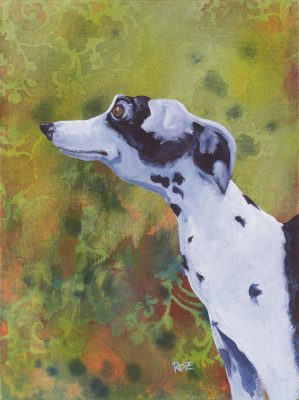
I personally don’t like gouache mixed with white pigment and have written extensively about that in the past—short version: I find mixing colors manufacturers have created by including white pigment generates murkier mixes.
I like doing all my color work first with gouache paint that is single pigment and contains no white paint.
Then I mix tints (color plus white paint) to add on later as I did in the Buster portrait).
The exception would be white fur or feathers. If an animal is predominantly white I will lay in white paint and then blend color pigment into that white base. “Clicker Training,” the portrait of the white and “black” dog in this post is an example of this white first approach. (Note: There is no black paint in that painting I have mixed dark neutrals using a limited palette of complementary colors.)
Companies like Schmincke and M. Graham do not use any fillers in their gouache lines. They have the same artist quality pigments they put in their watercolor line only ground more coarsely.
Because of this I have found that I can use their gouache both opaquely and translucently as desired over the surface of a painting. It’s great fun to have the options. But most important, as I stated in my post Monday and the accompanying video, opacity matters to me.
What matters to many gouache users is also the matte look of the surface of their painting. (That matters a bit to me too—I don’t like glare, and I love the way color pencil and pen all work well on a flat matte gouache surface.)
What does this all mean to someone concerned about finding gouache without acrylic in it as the questioner is?
Essentially all traditional gouache is without an acrylic component.
Here’s where it gets interesting, because there are acrylic paints labeled gouache!
Since the middle of the 20th century with the development of acrylic paint, many advertising artists who were masters of gouache (ideal for illustration because the matte surface of the gouache didn’t reflect glare when being shot for reproduction) switched to acrylic paints.
There are a lot of advantages to working in acrylic paint if you’re an illustrator—speed of drying, the ability to easily layer colors without messing up earlier layers of color, the ease of making client corrections without having to repaint the entire illustration, and the ability to get a more “oil-painterly” look with impasto acrylic paint applications.
But most brands of acrylic paint dry with a plastic, reflective look. To get a matte look in acrylics you have to include matte medium in your paint mix, or spray your finished piece with matte varnish. (I haven’t looked recently at acrylic paints but as of 10 years ago Lascaux was the only brand making an artist quality tube acrylic that dried matte. It’s pricey, but if that’s what you’re looking for it would be worth it. It was also pretty low odor.)
Paint companies are always looking to expand products and get a greater market share.
To this end they began making acrylic paints which had matte surface qualities and they called these products “Acrylic Gouache” or some riff on that label—e.g. Holbein’s very popular line is called Acryla Gouache.
These products are not traditional gouache because they do not use gum Arabic as a medium. Instead they use an acrylic medium. The acrylic medium is water resistant.
But they are marketed as a “gouache” because they dry with a matte surface like traditional gouache.
Depending who you are and what you do with your art, those acrylic qualities might be useful to you.
A Little History Break
While traditional gum-Arabic-based gouache has been in existence for thousands of years (a variation of it can be see on the sarcophagus portraits of Christian Eqyptians in 100 CE; Albrecht Dürer was drawing bunnies and other things on laid paper with his variation of traditional gouache; 18th century silversmiths were painting gouache design renderings of their teapots and silver service on toned paper; in the 19th century John Ruskin was giving readers clear instructions on how to grind gouache from paint cakes; and before and after the turn of the 20th century artists like Alphonse Mucha and many others were making advertising and home decoration illustrations as well as fine art on toned paper using gouache) it wasn’t until the early 20th century that gouache got a commercial push. It was released as a prepared paint for people working in the textile industry—so they could easily paint the fabric patterns for rugs with distinct colors—essentially diagrams for the weavers.
Over the 20th century gouache got a bad reputation as an illustration medium, not a fine art medium. The specter of oil paint always pushed other media out of the fine art realm. But if you want to spend a little time doing research you’ll find a rich, varied, loyal following of artists working with gouache and with watercolor used opaquely.
There was one huge problem with traditional gouache: OK two problems, but only one of them huge, with commercial gouache in the early 20th century.
First gouache was always water-soluble.
That’s the not huge problem. Anyone who puts in a bit of thoughtful practice with gouache can learn to control the water so that subsequent layers of paint do not pick up and disturb the earlier layers. Let’s face it, watercolorists have to practice glazing in order to layer colors, and it’s really a similar thing that happens in gouache. In watercolor the early layers need to be dry so you can flood the area with new color or brush on new color and not disturb the first color.
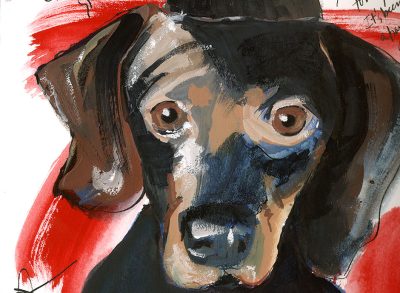
In gouache mostly you let early layers dry and then apply dry-ish paint over those layers so that the broken-dry-brush color you applied last allows the earlier layers (you allowed to dry first) to show through.
Again, that’s the easy issue. Something you can learn.
The more difficult, or huge problem with early commercial gouache is that since it was an illustrator’s paint and illustration was meant to last only long enough to be reproduced in print, longevity wasn’t a goal for gouache manufacturers. Dyes were often used in the creation of gouache paints.
When you paint with a gouache paint that contains dyes you end up having colors bleeding up from the bottom layers through the top layer. The moisture from the top paint layer would soften the bottom layer just enough that it would allow the dye to creep upwards. So imagine if you had a white section of your painting over another color—by the time that top layer of white dried the green or red or whatever from below would start to show in the top layer.
This isn’t something you can really control easily even if you’re a master with water control and keep your paint as dry as possible. And if it occurs it means you have to redo the entire area. And because gouache is noted for flat layers of color, revisions to layers can stick out like a sore thumb.
That’s what the huge problem was.
Acrylic versions of gouache were formulated in part to deal with that bleeding up issue.
Funny thing is as late as the 1980s Holbein Acryla Gouache was itself still bleeding up into top layers. I’m not saying they were using dyes in the paint at that time; I have no idea how they were formulating their paint. I’m saying that in the 1980s I spent considerable time working on a portrait with Holbein Acryla Gouache and even though early layers were allowed to dry completely, bottom (dried) layers of color bled up.
I also did a series of Acryla Gouache scenes where most of the colors were tints—i.e., mixed with white paint. The bleeding of under colors was rampant and so frustrating that the series was discontinued. This was particularly frustrating—since the paint has an acrylic medium it should have been more water resistant. These experiences with Acryla Gouache, and the fact that they were using many more fugitive pigments than I felt comfortable using, caused me to abandon that brand. I still have friends who enjoy using it. I don’t know if Holbein has improved the paint. I’m happy with traditional gouache because I can control it.
Back to the Issue of Acrylic Gouache
In today’s paint market traditional gouache is labeled as gouache.
Acrylic paints drying with a matte surface and having other characteristics the manufacturer deems appropriate will be labeled as Acrylic Gouache in some way (with those words or similar nomenclature).
I know of several brands of acrylic gouache on the market. Holbein makes the AcrylaGouache I wrote about above. Turner Acryl Gouache is also made by them I believe.
Liquitex has an Acrylic Gouache.
Lascaux is the only Acrylic gouache that doesn’t seem to have acrylic on the labeling CLEARLY and prominently. The jar seems just to say Gouache. I find that confusing, but I don’t have a jar in hand so there may be additional labeling I can’t see in a product photo.
All of those acrylic gouache are called gouache because the manufacturers created an acrylic paint that dries with a matte finish instead of the plastic-y finish of acrylics. Since real gouache (i.e., Gum-Arabic based, water-soluble gouache) has a matte finish when compared to its cousin watercolor the powers that be decided that using the word “gouache” in the labeling of some of their acrylic products would be a good idea.
If you see a product labeled simply as Gouache except in the one case I’ve just mentioned the product SHOULD only contain water-soluble ingredients and have either a gum Arabic binder/medium, OR some new synthetic one (which I haven’t heard of any but I mention this as an option because we have Golden’s Watercolors with no gum Arabic and instead using a synthetic medium, still water-soluble so it isn’t acrylic; it seems likely someone will come up with a synthetic medium for gouache that is still water-soluble).
Traditional Gouache
It seems simplest to call gum-Arabic-based gouache traditional gouache. This is your water-soluble paint.
If you buy traditional gouache from:
Schmincke
M. Graham
Daniel Smith (gouache is a new product from them; I have only done a very quick test with this. Odor is not an issue with this paint. It will probably be fall before I have an opportunity to experiment with it as I’m still moving my studio.)
Holbein (gouache, NOT their Acryla Gouache!)
You’ll be getting gum Arabic in the above paints and not acrylic anything and if you do OK with the ingredients in the watercolors from those same companies you’ll be fine with their gouache.
Other traditional gouache includes:
Winsor and Newton (which I don’t recommend because of odor; I find their gouache has a strong chemical odor)
Stoneground Gouache Pans (which you can watch my review off in Monday’s post, I’m not pursuing it as I think other options are better)
There are probably others that I’m not aware of as I haven’t actively been testing materials for the past 4 years or so.
But the above top 3 (Schimincke, Daniel Smith, and M.Graham gouache are all artist quality paints.)
Things not on this list aren’t artist quality. If you pick a non-artist quality traditional gouache be aware that while you won’t be getting an acrylic paint (which is what the original questioner was trying to avoid) you are likely to get some additives that you may be allergic to.
And most of the student grade gouache has chemical odors and since it’s the odors that are bothering you I’d avoid all those.
If odors are what bothers you, that’s not an issue limited to Acrylic Gouaches.
Even traditional gouache can have odor issues.
Best to avoid Arteza and all the Korean, Japanese, and Chinese brands unless you could smell a sample. I’ve had products from companies from Asia that have both or either chemical or floral odors that are overwhelming, and Arteza just is student grade materials.
If you aren’t sensitive to odors like the questioner was then you can experiment with these other brands. Just be aware that it is important to have paints with quality pigments and a high pigment load for best results. Your time is money. And you’re wasting your time and money using the non-artist quality paints.
Odor issues can sometimes exist along with contact issues so if you get one of the top four on my list (down to Holbein) you should be OK, though Holbein may be problematic as it’s formulated a bit differently. I’d avoid W&N as stated above.
When in doubt just look at the labels and see that they are using gum Arabic and not an acrylic polymer.
I hope this helps you all find a traditional gouache or acrylic gouache that you enjoy working with.



















